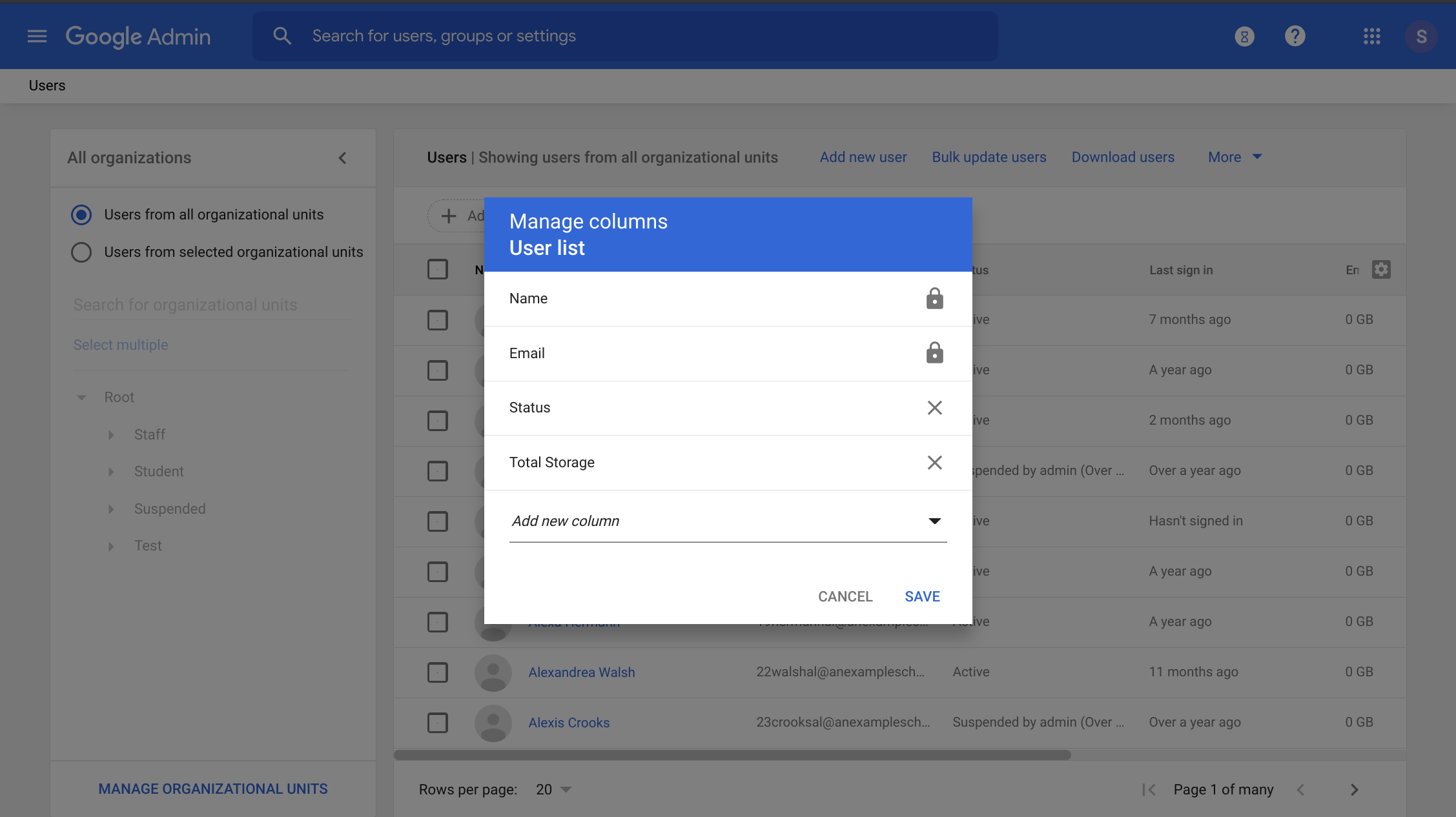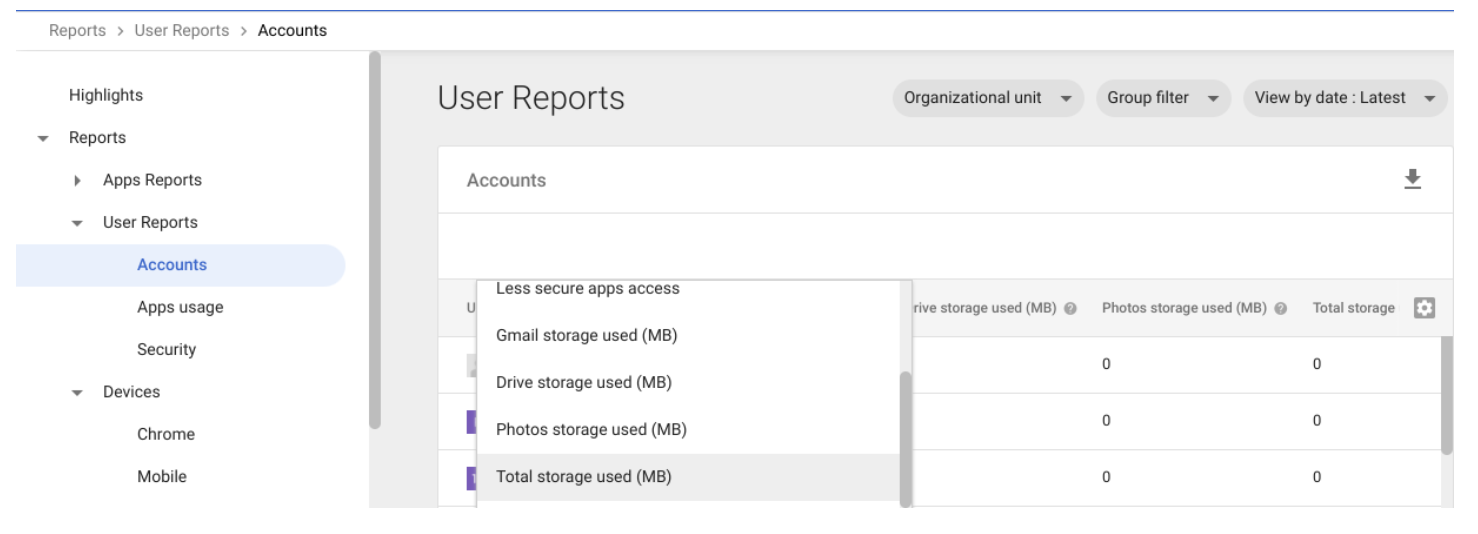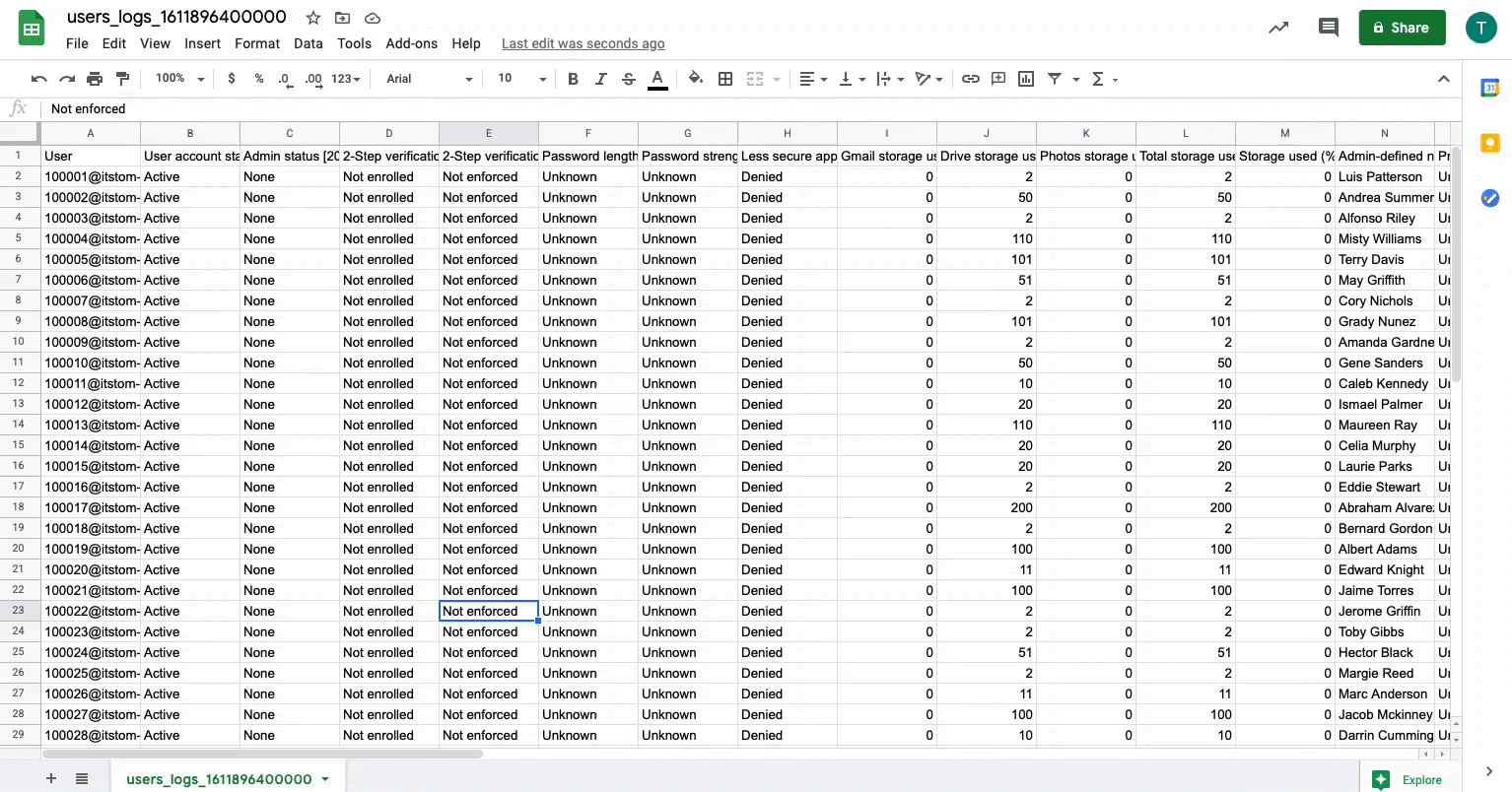
These updates and timeline are written as of 2/17/21
Starting in July 2022, schools will be given 100TB of combined Drive, Gmail, and Photos storage for free. After you’ve reached the max storage allocation per domain (100TB), you will need to curb your cloud storage usage or procure a paid Google Workspace edition. Since the change is scheduled for July 2022, there is ample time to plan for the impact. First, you will want to understand your organization’s current storage usage and make a plan from there.
Thankfully, Google has made it relatively easy to get the Google Workspace storage usage information for users within your organization. The first option is to download a list of your users from the Admin Console’s Directory > Users page. With this method, you will need to include the “Total Storage” column for the export. This may increase the size of the output file but will give you a downloadable list of user information which includes Total storage (Mb).

Another method within the Admin Console is to use the User Accounts report. Navigate to Reports > Accounts > Accounts. When exporting this report, keep in mind it is limited to 100,000 entries.
A couple of options are available after navigating to the reports in the admin console.
Apply Filters
You can apply a filter to only show users who match certain criteria. Users who are in a particular OU or who are using more than a given amount of Total Used Storage. The Organizational unit and Group filter options at the top provide an opportunity to look at different roles with different sets of criteria. Adding in the Total storage used filter cuts out any light storage users as well as any newly created users.

Where organizational unit-based quotas are something that will be able to be configured, it would be a good idea to start with users with higher quotas, or those that are approaching their soon-to-be-imposed limits.
Exporting Data
If filtering users by Role and Total storage usage gets the total number of entries under the Export limit, you can limit the output to pertinent information for the search. To do this, click the settings gear in the right of the table, and remove any columns from the export which are not needed to evaluate your users. This is an optional step, but will greatly help with cleaning up the data to prepare for evaluation.
Once you have saved the relevant columns, click the Download icon in the top right corner of the Report page. This will queue the report in your Admin Console Tasks. When it is completed you will be able to find the link to the completed report.
Opening the report, we recommend applying a filter to the list and sorting the Total storage usage (MB) column in reverse alphabetical order (Z-A) to see the users with the most storage used.

Using GAM
If filtering the report’s data does not get your list down below the limit within the Admin Console export, another option to get the information would be to use GAM. This open-source tool leverages Google’s APIs to gather information about your Google Workspace domain.
The following GAM command can be used to get the same information as outlined above using the Admin Console’s Reports page. Note that the used_quota_in_mb>1024 value can be changed to the size you’re wanting to filter by.
gam report users filter ‘accounts:used_quota_in_mb>1024’ fields accounts:used_quota_in_mb,accounts:drive_used_quota_in_mb,accounts:gmail_used_quota_in_mb,accounts:gplus_photos_used_quota_in_mb > storage_usage.csv
Understanding the syntax
The part of the command after the last > tells GAM to output the data to a file; in this case, storage_usage.csv in the current directory. You can add any absolute or relative path to store the report as a file. The string following fields is the list of columns you want to include in the report. Additional helpful fields can be found here and include:
accounts:is_suspended
accounts:last_login_time
gmail:timestamp_last_interaction
drive:timestamp_last_active_usage
These additional fields can be added to the command, separated by a comma without any spaces to include the associated information in the report.
Next steps
Now that you have a list of usage for your users on your domain you can determine which users from the list need action taken. If everyone is within the expected quotas, no additional action is needed before applying Storage quotas to users. If there are a handful of users that are over-using your Google Workspace Storage, it may be worth having the users determine what is worth keeping and what needs to be removed. Amplified IT has put together a Slides Presentation to help end-users take care of their data usage.
Once you have generated the reports using the admin console and GAM, you can easily visualize your data in a simple Data Studio visualization. We created a quick template that you are free to copy and use that will connect directly to the two CSV files you create. This visualization will help you determine the largest users as well as the largest files and even file types. You can download the template here (http://ampd.it/3jZydOF). This is a one time look but it will give you quick insight into current drive storage use. If you would like help setting this up we would be happy to help you using support hours.
Keep in mind that there may be suspended users that are eating into the domain’s overall quota as well. These users are included in the above reports and can be filtered accordingly. For suspended users, or if you are wanting to investigate usage more in-depth, we’ve written a separate guide to help with taking action on user’s files.
-

Catherine Weers
Onboarding & Engagement Consultant -
About the Author:
Catherine lives in Virginia Beach, walking distance to the Chesapeake Bay where she is Amplified IT’s Google for Education Onboarding and Engagement Consultant. Catherine joined the Amplified IT team in 2017 after serving in public schools for 13 years as a teacher in addition to various technology roles. Her current role as Onboarding and Engagement Consultant allows ample opportunity to empower schools, while sharing best practices to get the most out of the cloud solutions they adopt. In her spare time, you can find her at the beach with her family, likely chasing her 2 young daughters and petting all the dogs.


